Moravian Church History Collection (12 vols.)
Digital Logos Edition
Overview
Credited with starting the modern mission movement and inspiring the events of the Reformation in the sixteenth century, the Moravian Church formed after leader John Huss (Jan Hus) was burned at the stake for promoting church reform. Huss championed such ideas as justification by grace through faith alone, full communion for laypeople, and adoption of the liturgy to the common language of the people. After his death, his followers fought and died to protect those ideas in what came to be known as the Hussite Wars. The 12 volumes in the Moravian Church History Collection cover the history of the Moravian Church, documenting the origin of the movement, the fight for independence during the Hussite Wars, the important leaders that led a people through decades of persecution, and the amazing evolution into a church that followed in the Apostles’ footsteps, sending missionaries worldwide to spread the good news.
The Moravian Church History Collection also includes numerous works on the theology of the Moravian Church, among them a fifteenth-century catechism, a volume containing the liturgy and hymns of the church, the church constitution in Latin and English, and more. Two biographical works cover the lives of Zinzendorf, “the father of modern missions,” and Comenius, “the father of modern education.”
Like that of the the Waldensians, the history of the Moravian Church is vital to understanding the atmosphere that preceded the Reformation. In the Logos edition of Moravian Church History Collection, all Scripture passages are tagged and appear on mouse-over. For scholarly work or personal Bible study, this makes these texts more powerful and easier to access than ever before. With the advanced search features of Logos Bible Software, you can perform powerful searches by topic or Scripture reference—finding, for example, every mention of “grace” or “Matthew 28:19–20.”
This title is included in the following collections
You can save when you purchase this product as part of a collection.
Logos 8 Methodist & Wesleyan S...
$349.99$349.99Logos 7 Methodist & Wesleyan S...
$349.99$349.99Logos 8 Methodist & Wesleyan G...
$849.99$849.99Logos 7 Methodist & Wesleyan G...
$849.99$849.99
- $849.99
- $1,499.99
- $1,499.99
- $1,499.99
- $2,999.99
- $11,399.99
- $11,399.99
- $21,749.99
- $24,999.99

- 12 volumes on the history and theology of the Moravian Church
- Biographies of Nicholas Zinzendorf and John Amos Comenius
- In-depth coverage of the Hussite Wars
- Treatment of the beginnings of the modern mission movement
- Title: The Moravian Church History Collection
- Volumes: 12
- Pages: 4,996
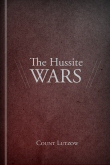
Led by John Huss, the movement that eventually became known as the Moravian Church began in the late fourteenth century. After Huss was declared a heretic and burned at the stake in 1415, his followers began a rebellion against the Catholic Church that lasted nearly 15 years and claimed the lives of many. Count Lützow’s The Hussite Wars covers this period of turmoil, starting with the protest over Huss’ death at the Council of Constance on September 2, 1415. From there, the revolution for religious and civil liberties led to violence and war, where the Bohemians often found themselves greatly outnumbered on the battle field. Lützow documents the battle strategies of the Bohemians, the genius of the Hussite military leaders, and the large influence that Hussite teachings would have on Bohemia and its neighboring countries.
Will remain for many years the standard treatment of the Hussite Wars.
—Homiletic Review
Count Lützow has had the benefit of many hitherto unknown documents in the Bohemian, and this makes his book valuable as history.
—Boston Transcript
Count Lützow’s narrative of a courageous struggle for religious, national, and popular liberties makes enthralling reading.
—Saturday Review
Count Lützow (1849–1916) was an author and historian who contributed greatly to Czechoslovakia’s independence from the Austro-Hungarian Empire. His notable works on Bohemian history, literature, and politics include A History of Bohemian Literature, The Story of Prague, Life & Times of Master John Hus and Lectures on the Historians of Bohemia.
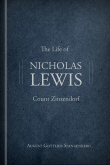
The Life of Nicholas Lewis Count Zinzendorf gives a detailed account of the life and work of this important Moravian Church bishop. In 1722, Zinzendorf opened a large portion of his estate to a number of families suffering from religious persecution. There they built a small village and adopted Christian communal living principles in line with Moravian Church teachings. This community, rooted in many different denominational backgrounds, emphasized a single code of Christian behavior over specific doctrines or beliefs. The community was a success, and future Moravian communities would model themselves on it—the modern mission movement, in fact, is thought to have originated from this community. This volume covers the extraordinary life of a man who led an extraordinary movement.
August Gottlieb Spangenberg (1704–1792) was a bishop in the Moravian Church and the successor of Count Zinzendorf. He helped develop international missions, as well as stabilize the theology and organization of the German Moravian Church.
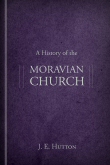
Spanning the vast history of the Moravian Church, J. E. Hutton’s A History of the Moravian Church begins in 1415 with the execution of John Huss, covers the revival of the church under Zinzendorf in the 1700’s, and shows the progress and growth of the Moravian Church up to the twentieth century.
J. E. Hutton (1868–1937) was an English Moravian minister and author. He pastored the Fairfield Moravian Church from 1922 to 1934.
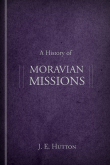
A History of Moravian Missions, J. E. Hutton’s follow-up to A History of the Moravian Church, chronicles the birth of the modern mission movement, which can be traced back to Count Zinzendorf—the “father of modern missions.” Beginning in 1700 with the first Moravian missionaries, this volume is divided into four parts:
- The Eighteenth Century Pioneers, 1700–1800
- The Builders, 1800–1914
- The Modern Advance, 1848–1914
- Methods, Measures, and Ideals
J. E. Hutton (1868–1937) was an English Moravian minister and author. He pastored the Fairfield Moravian Church from 1922 to 1934.
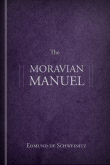
The church sect commonly known as the Moravian Church actually has many different names: The Moravian Church, The United Brethren, The Church of the Moravian United Brethren, and The Unitas Fratrum. This volume contains a short history of this body of believers and a survey of the state of the church in the mid–nineteenth century. It is followed by the church’s constitution, a compendium of church doctrine, and a section of its ecclesial hierarchy. Also included are chapters on worship practices and church discipline and notes on the church’s missionary endeavors. This volume is a great reference work for quickly exploring Moravian church doctrine and practice.
Edmund de Schweinitz (1825–1887) was born in Bethlehem, Pennsylvania and educated at the Moravian Seminary there. He founded and edited Moravian, a weekly journal, and authored numerous works, including The Moravian Episcopate, The Life and Times of David Zeisberger, and Some of the Fathers of the Moravian Church.
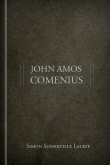
Considered the “father of modern education,” John Amos Comenius was a Czech teacher, educator, and writer. In 1614 he was ordained into the ministry of the Moravian Brethren, and he considered pastoral work the most important of all his duties. His influence over education, however, would be his greatest legacy, and in his work Didactica Magna, he outlined a school system that would be generally adopted worldwide. Other important works of his influenced the general theory, the subject matter, and the method of education. Alongside his pastoral work and travels, Bishop Comenius still found time to write religious works and hymns. This volume chronicles his life, travels, works, and legacy.
Mr. Laurie deserves the thanks of the educational world for his sketch of a remarkable man, whose success, in an unworldly sense, was great, and whose failures are almost more instructive than his success.
—Athenaeum
Mr. Laurie has given us a good memoir of John Amos Comenius, the earnest, simple-minded Moravian Bishop, who set about reforming the schools of Europe in the midst of the confusion of the Thirty Years’ War. His name is far less known than it deserves to be, and Mr. Laurie has done good service in erecting this monument to his memory.
—Westminster Review
The work is a systematic, earnest, and conscientious effort in educational biography. The introduction, which seeks to explain the relation of Comenius to the Humanistic and Realistic Schools, which were the outcome of the Renaissance, is well thought out and well written, and the analysis of Comenius’ educational writings is executed with intelligence and thoroughness.
—Scotsman
Simon Somerville Laurie (1829–1909) was born in Edinburgh and educated at Edinburgh University. He held the post of secretary to the education committee of the General Assembly of the Church of Scotland for fifty years and wrote numerous works on educational theory. Laurie was thus involved with almost all the practical developments in the provision of education in Scotland for half a century. His works include Historical Survey of pre-Christian Education, Lectures on Language and Linguistic Method in the School, and Handbook to Lectures on the Theory, Art, and History of Education.
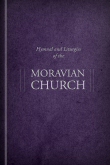
The Hymnal and Liturgies of the Moravian Church was presented to the congregations of the Moravian Church in America in accordance with a series of enactments of the Synods of 1913 and 1920. This edition has behind it a long and noble ancestry. It is the lineal descendant of the earliest collection of its kind. The Moravian Church was the first among Protestant churches to publish a hymn book; it first appeared in the Bohemian language in Prague in 1501. Preceding the hymnal are the liturgies of the Church.
Hymnal and Liturgies of the Moravian Church contains nearly 1,000 hymns celebrating the Moravian tradition. It includes an alphabetical and metrical index of tunes, an index of composers, an index of authors, a topical index, and an alphabetical index of first lines.
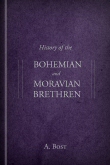
In this volume on Moravian Church history, A. Bost champions the argument that, like those of the Waldensian Church, the Moravian Church’s roots can be directly traced back to the primitive church.
Ami Bost (1790–1874) was born in Geneva and educated by the Moravian Brethren. Ordained in 1814, he worked as a revival missionary for the Continental Church Society of London. His works include Letters and Biography of Felix Neff and a three-volume memoir.
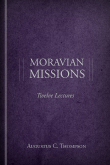
These lectures, originally given to Andover Theological Seminary and to the Theological Department of Boston University, illustrate the power and effectiveness of the missionary work of the Moravian Church. The first describes the origin, faith, polity, and discipline of the Unitas Fratrum, as the brotherhood is called. The second gives a detailed account of Zinzendorf, the German nobleman, under whose influence the spirit of evangelization was developed. The remaining lectures trace several lines of missionary efforts that span the globe.
It will be remembered how much Wesley owed to the Moravians, and indeed nearly all denominations owe much to them. Dr. Thompson’s volume—which is very thorough, and the result of a faithful study of the records—will do much to draw attention to the subject. To theological students it should be especially recommended.
—British Quarterly Review
The Moravian Mission will always be intensely interesting, and Dr. Thompson has written his important volume in the consciousness of that.
—London Quarterly Review
Exceedingly instructive and spiritually stimulating. The very nature of the fields in which the missionary work of the Moravians has chiefly lain, has made that work a wonderful test of the nature and wonderful illustration of the power of the Gospel.
—The Presbyterian Review
Not the least interesting feature in the author’s method is his skillful interweaving of confession and testimony from the lips of native converts, revealing with life-like clearness the change through which they have passed, and the measure of character and spiritual perception they have gained. Indeed, as a whole, the book blends the charm of romance with the worth of reality, and deserves the attention of all who would follow the noblest work and the most heroic workers of our times.
—The Literary World
Augustus C. Thompson (1812–1901) was the author of numerous books on missionary work, including Foreign Missions, Protestant Missions: Their Rise and Early Progress, Modern Apostles of Missionary Byways, and Songs in the Night: Hymns for the Sick and Suffering.
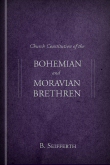
Church Constitution of the Bohemian and Moravian Brethren contains the Moravian Church constitution in the original Latin with an English translation, notes, and introduction by Bishop B. Seifferth of the Brethren’s Church.
The editor of this volume deserves the thanks of all who are interested in the spread of a purer Gospel faith and discipline, and we cordially commend its candid and careful perusal to all who wish to obtain many useful hints regarding the most appropriate means that may be adopted in furthering both the inward and outward work of the house of God.
—Biblical Notes and Queries
Both those who are prepared, and those who are not, to accept the Moravian claim to the apostolic succession, will be glad to get this help from the study of a system of discipline, which Luther, Vergerio, and Thorndike, concurred in preferring to every other in Christendom—framed, before the appearance of Luther, by a body who partly defended their peculiarities on the grounds of Greek extraction and Wycliffite teaching, and at this day maintained, in most of its features, throughout the wide-spread missions which owe to it (instrumentally speaking) both their existence and success.
—Colonial Church Chronicle
B. Seifferth (1796–1876) was a Bishop in the Brethren’s Church and the author of Memoranda and Letters Relating to the Moravian Congregation.
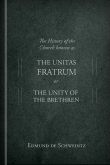
This volume covers the history of the Moravian Church from 451 to 1722. The object of Edmund de Schweintitz’s History is to “furnish a work of reference for scholars who may wish to consult the authorities upon which the facts are based.” Hence, Schweinitz has included abundant references in the footnotes and a complete table of the literature relating to the subject.
This book supplies a need long and widely felt. The history of what is now commonly known as The Moravian Church but which is also called the Unitas Fratrum, The Unity, The Bohemian Brethren, The Brethren, and the Brethren’s Church, is one of thrilling interest. Its founders were Reformers before the Reformation, and the story of their ardent faith, their noble deeds, and their cruel sufferings, the world will not willingly let die. The book is written in good style and is pervaded by an excellent spirit. It is not only interesting, but also very refreshing and profitable reading.
—The Reformed Quarterly
The early history of the Brethren was made in suffering, exile, torture, and blood. Their later history has been marked by evangelical sincerity and missionary devotion unsurpassed in modern times, and almost apostolic.
—Baptist Quarterly Review
Since the first publication of this history in 1885, it has remained the standard, indeed the only, work in English on the subject, a work of high importance in the history of Protestantism.
—Outlook, 1901
Edmund de Schweinitz (1825–1887) was born in Bethlehem, Pennsylvania and educated at the Moravian Seminary there. He founded and edited Moravian, a weekly journal, and authored numerous works, including The Moravian Episcopate, The Life and Times of David Zeisberger, and Some of the Fathers of the Moravian Church.
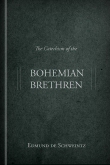
The Bohemian Brethren devoted great attention to catechisms, and made constant use of them when giving religious instruction, especially to the young. In their German Confession, published at Wittenberg in 1573, they say, “In addition to the Holy Scriptures, we teach the Catechism, that is, the doctrines which the old Church and the holy Fathers held in common, and the oral instructions which they delivered, constituting the kernel of, and the key to, the entire Bible.” This volume contains an English translation of a German catechism first published in 1522.
Edmund de Schweinitz (1825–1887) was born in Bethlehem, Pennsylvania and educated at the Moravian Seminary there. He founded and edited Moravian, a weekly journal, and authored numerous works, including The Moravian Episcopate, The Life and Times of David Zeisberger, and Some of the Fathers of the Moravian Church.
Reviews
5 ratings

Scott J Sherwood
5/23/2016

Larry Proffitt (I
11/13/2013
Bobby Terhune
10/13/2013

Robert J Smith
9/22/2013

Faithlife User
7/12/2013